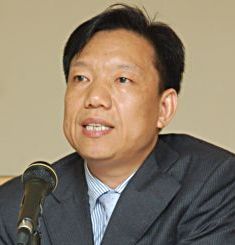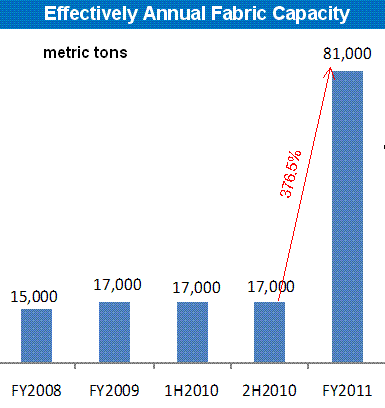
For example, China Gaoxian, the biggest polyester fibre producer listed on the SGX, recently posted a 7.5% year-on-year growth in earnings to Rmb 198.1 million for 1H10.
Ziwo, a niche chemical fibre player also listed on the SGX, grew earnings 12.2%.
Though only a third the size of Gaoxian, Ziwo has similarly fat gross margins --- in excess of 30%.
It produces 30D terylene filament yarn, sandwich mesh fabric, and foamed materials for manufacturers of sportswear, sports accessories, bags, and luggage.
Then there are others, like Foreland Fabritech, which had an earnings contraction of 75%, and China Fibretech, which saw its earnings decimated by 92.3% year-on-year in 2Q10.
What accounts for this stark difference?
China’s textile sector faces challenges such as manpower shortage and hikes in labor costs, Rmb appreciation (which affects exporters), and rising cost of raw materials.
Opportunities abound, nonetheless.
Its huge population of affluent consumers grows by the day and the nation is hungry for high-quality, high-performance differential fibers, which it mostly imports.
Excluding small players that are being edged out as the industry consolidates, retail sales in Chinese apparel surged 24.4% y-o-y in Jul to reach Rmb 38.8 billion, and is expected to grow more than 20% annually.
Unfortunately, most chemical fiber products in China are mainly conventional varieties, such as polyester, acrylic, nylon, viscose and other types.
|
In the meanwhile, developed countries' chemical fiber enterprises are paying more attention to the development of new products, with annual production reaching more than 100 varieties.
Japan, Korea, Taiwan and other such countries and regions have reached the fourth generation of ultra-simulated synthetics while most of China's differential fibers are only at the second-generation level.
A leading supplier of high-grade fine polyester yarn, China Gaoxian is one of the few in China with technology to compete against the high-grade imports.
By varying the physical, mechanical and chemical properties of the fibres (blending), Gaoxian produces substitutes for other fibres like silk or nylon, but with desirable properties added-on in terms of warmth, texture and feel, luster, tensile strength, as well as abrasion resistance.

Manufacturers of high end apparel, automobile upholstery, sports shoes and headgear, curtains, bedding, bags, and umbrellas pay a 10% to 25% premium for its yarns, allowing Gaoxian to generate gross margins in excess of 30% for each quarter since its IPO.
”Our market is wholly domestic,” emphasized Gaoxian CEO Cao Xiangbin during a NextInsight interview when the company posted its results.
Not only is the domestic market growing faster, this means the company does not need to worry about foreign exchange losses as the Rmb appreciates.
”Our strategy is to integrate vertically and horizontally,” said Mr Cao, referring to the company’s move to be involved in more stages along the supply chain and to widen its product range.
From spinning yarn, it began knitting fabric. It launched its own Warp Knit Fabric (WKF) in 2008, made from its own simulated yarns. Resistant to runs and relatively easy to sew, warp knit fabrics are commonly used in lingerie.
It is also developing higher-grade yarns. During the last quarter, it sold more of its higher-grade yarns, which are lighter (finer) but command higher selling prices.
It next step will be to produce feedstock for its yarns. Last month, it announced plans to build a factory for PET-chips, the key component for producing its synthetic yarns and fabric.

To house the new PET-chip factory, it has already inked a deal to pay Rmb 200 million for a plot of land next to its existing facility.
It also plans to ramp fabric production capacity up 5 times and yarn production capacity by another 25% by the end of next year.
”The advantage of being big is you have the scale to produce your own raw materials,” said Mr Cao.
And the advantage of vertical integration is better margins.
Polyester incidentally, is big business, accounting for 80% of chemical fibres produced in China, the world’s largest textile producer.
More than 1,500 textile and garment manufacturers use and acknowledge Gaoxian brands (Hua Gang and Da Hua Wei) as top grade.
These textile and garment manufacturers use Gaoxian’s wide range of yarns and fabric to manufacture apparels, upholstery for automobiles and aeroplanes, sports shoes and headgear, curtains, bedding, bags, and umbrellas.
As Gaoxian steadily ramps up capacity, its management expects production utilization rate to stay at an optimum level of 75% to 80%. Order books were Rmb 250 million as at 30 June 2010.
To fund its expansion, the company intends to fall back on its cash hoard of some half a billion yuan. It is also making plans to raise monies on the Korean bourse through depositary receipts.
Related story: CHINA GAOXIAN: Unloved stock (2.6X forecast 09 PE!) with great potential







